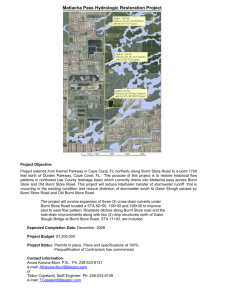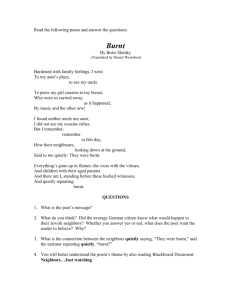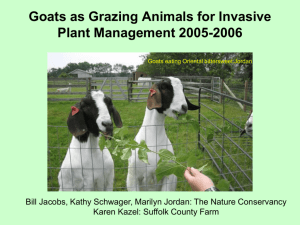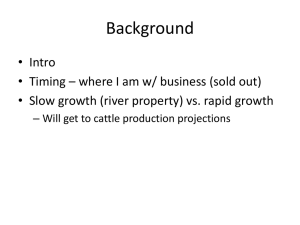ON A SAGEBRUSH SEMIDESERT SITE IN CENTRAL UTAH P. E. Rosten
advertisement
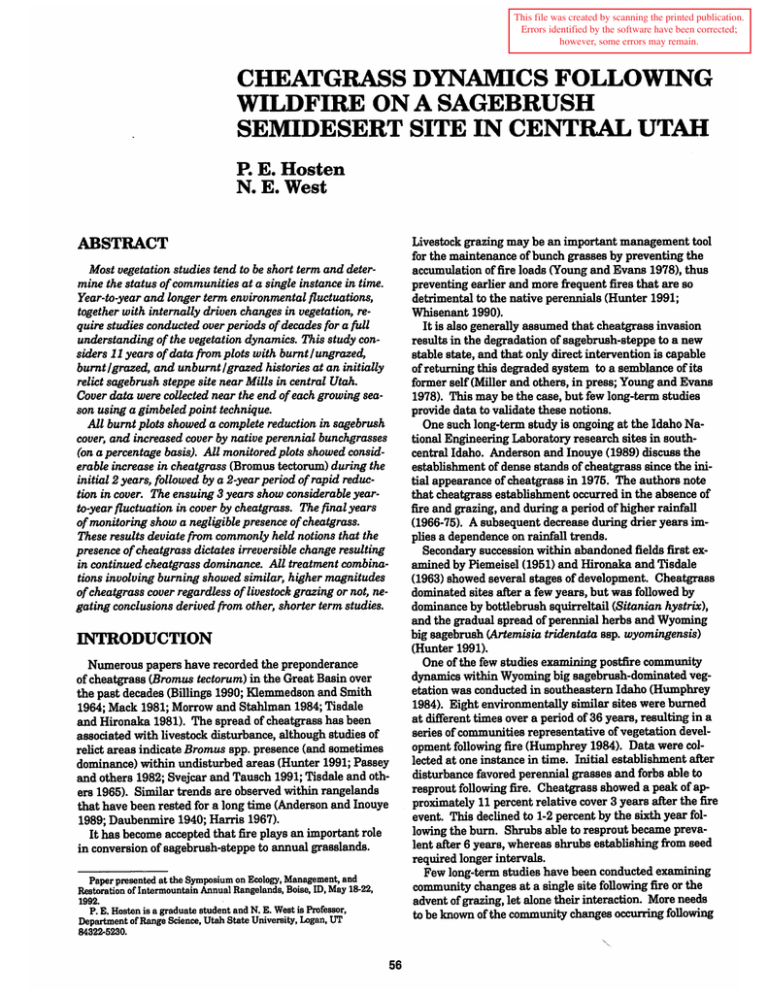
This file was created by scanning the printed publication.
Errors identified by the software have been corrected;
however, some errors may remain.
CHEATGRASSDYNAN.UCSFOLLO~NG
~LDFIRE ON A SAGEBRUSH
SEMIDESERT SITE IN CENTRAL UTAH
P. E. Rosten
N. E. West
ABSTRACT
Most vegetation studies tend to be short term and determine the status of communities at a single instance in time.
Year-to-year and longer term environmental fluctuations,
together with internally driven changes in vegetation, require studies conducted over periods of decades for a full
understanding of the vegetation dynamics. This study considers 11 years of data from plots with burnt I ungrazed,
burnt I grazed, and unburnt I grazed histories at an initially
relict sagebrush steppe site near Mills in central Utah.
Cover data were collected near the end of each growing season using a gimbeled point technique.
All burnt plots showed a complete reduction in sagebrush
cover, and increased cover by native perennial bunchgrasses
(on a percentage basis). All monitored plots showed considerable increase in cheatgrass (Bromus tectorum) during the
initial 2 years, followed by a 2-year period of rapid reduction in cover. The ensuing 3 years show considerable yearto-year fluctuation in cover by cheatgrass. The final years
of monitoring show a negligible presence of cheatgrass.
These results deviate from commonly held notions that the
presence of cheatgrass dictates irreversible change resulting
in continued cheatgrass dominance. All treatment combinations involving burning showed similar, higher magnitudes
of cheatgrass cover regardless of livestock grazing or not, negating conclusions derived from other, shorter term studies.
INTRODUCTION
Numerous papers have recorded the preponderance
of cheatgrass (Bromus tectorum) in the Great Basin over
the past decades (Billings 1990; Klemmedson and Smith
1964; Mack 1981; Morrow and Stahlman 1984; Tisdale
and Hironaka 1981). The spread of cheatgrass has been
associated with livestock disturbance, although studies of
relict areas indicate Bromus spp. presence (and sometimes
dominance) within undisturbed areas (Hunter 1991; Passey
and others 1982; Svejcar and Tausch 1991; Tisdale and others 1965). Similar trends are observed within rangelands
that have been rested for a long time (Anderson and Inouye
1989; Daubenmire 1940; Harris 1967).
It has become accepted that fire plays an important role
in conversion of sagebrush-steppe to annual grasslands.
Paper presented at the Symposium on Ecology, Management, and
Restoration of Intermountain Annual Rangelands, Boise, ID, May 18-22,
1992.
P. E. Hosten is a graduate student and N. E. West is Professor,
Department of Range Science, Utah State University, Logan, UT
8432~5230.
56
Livestock grazing may be an important management tool
for the maintenance of bunch grasses by preventing the
accumulation of fire loads (Young and Evans 1978), thus
preventing earlier and more frequent fires that are so
detrimental to the native perennials (Hunter 1991;
Whisenant 1990).
It is also generally assumed that cheatgrass invasion
results in the degradation of sagebrush-steppe to a new
stable state, and that only direct intervention is capable
of returning this degraded system to a semblance of its
former self (Miller and others, in press; Young and Evans
1978). This may be the case, but few long-term studies
provide data to validate these notions.
One such long-term study is ongoing at the Idaho National Engineering Laboratory research sites in southcentral Idaho. Anderson and Inouye (1989) discuss the
establishment of dense stands of cheatgrass since the initial appearance of cheatgrass in 1975. The authors note
that cheatgrass establishment occurred in the absence of
fire and grazing, and during a period of higher rainfall
(1966-75). A subsequent decrease during drier years implies a dependence on rainfall trends.
Secondary succession within abandoned fields first examined by Piemeisel (1951) and Hironaka and Tisdale
(1963) showed several stages of development. Cheatgrass
dominated sites after a few years, but was followed by
dominance by bottlebrush squirreltail (Sitanian hystrix),
and the gradual spread of perennial herbs and Wyoming
big sagebrush (Artemisia tridentata ssp. wyomingensis)
(Hunter 1991).
One of the few studies examining postfire community
dynamics within Wyoming big sagebrush-dominated vegetation was conducted in southeastern Idaho (Humphrey
1984). Eight environmentally similar sites were burned
at different times over a period of 36 years, resulting in a
series of communities representative of vegetation development following fire (Humphrey 1984). Data were collected at one instance in time. Initial establishment after
disturbance favored perennial grasses and forbs able to
resprout following fire. Cheatgrass showed a peak of approximately 11 percent relative cover 3 years after the fire
event. This declined to 1-2 percent by the sixth year following the bum. Shrubs able to resprout became prevalent after 6 years, whereas shrubs establishing from seed
required longer intervals.
Few long-term studies have been conducted examining
community changes at a single site following fire or the
advent of grazing, let alone their interaction. More needs
to be known of the community changes occurring following
these disturbances if we are to ably manage our rangelands. This study is aimed at increasing our understanding of community dynamics within burnt and ungrazed,
burnt and grazed, and unburnt and grazed treatments.
500
400
STUDY SITE
~
w_
!!!.E
300
2
200
(j
100
Q.
The study site is located near Mills in central Utah
(Section 30, R2W, T15S, Salt Lake Meridian), Juab
County, on a pediment remnant. Slopes are 1-2 percent
east facing, and elevation ranges from 1,617 to 1,622 m
(5,305-5,320 ft). For further details see West and Hassan
(1985).
z!
E
ii:
w
a:
METHODS AND MATERIALS
0..
A wildfire swept through the study site shortly after
collection of the "pretreatment" data in 1981. Patchy
burning of the site resulted in a natural experiment allowing the investigation of changes in burnt and unburnt
patches under grazed and ungrazed conditions. Figure 1
summarizes the history of this study. Pretreatment data
were collected on four macroplots (20 by 50 m) in 1981.
The plots were fenced after the burn, but prior to the second season of data collection. Additional plots (three per
treatment) were selected to represent the burnt-grazed
and unburnt-grazed treatments. Livestock grazing was
initiated after the establishment of watering points prior
to the 1982 data collection season. The site may have
supported light winter grazing by sheep before the start of
the study. A second light wildfire occurred during 1987.
One replicate of the burnt-grazed treatment was inadvertently lost due to chaining prior to the 1988 data collection
season.
82 83 84 85 86 87 88 89 90 91
YEAR (1982- 1991)
Figure 2-Precipitation records for the Mills
study site (September-June; 1981-92).
Data were collected using a gimbeled point technique
(Winkworth and Goodall1962). One hundred points were
sampled per macroplot, and interpreted as percentage
cover. Data are presented as means with vertical bars
representing the range of values for the treatments.
PRECIPITATON
Figure 2 indicates that the years 1987 to 1991 were considerably drier than the preceding years. Nineteen eightythree appears to have been the wettest year according to
existing data.
~ light wtldflnt '86 - '87
1981
PERCENTAGE LIVE PLANT COVER
1988 ... 1991
1982 ... 1987
No clear differences in total percentage live plant cover
occurred between treatments (fig. 3), although the burnt
and ungrazed (BU) treatment generally shows a higher
percentage live plant cover than the burnt and grazed
(BG) and unbumt and grazed (UG) treatments.
selection of
eddtttonel plots
plots
consumed
by
wildfire
===$
selection
of
eddlttonel
Plots
0
0
0
bumt end grezed
GROWTH FORMS
Four growth forms are considered in this section. Two
natural groups are shrubs and perennial grasses. Halfshrubs represent a less distinct group. Since forbs comprised a small proportion of the plant community in this
study, perennial and annual forbs are considered as a
whole within the forb class. Cheatgrass represents an annual grass functional group, but is considered as an individual species.
Figure 4 (tree and shrub cover) shows only slight fluctuations in shrub cover within the UG treatment. Shrubs
show no recovery in either the BU or BG treatments following the 1981 wildfire.
=:::$
unbumt end ungrezed
D
0
0
one
plot
lost
due
to
chetntng
bumt end ungrezed
0
unbumt end grezed
Figure 1-Graphical representation of the experimental design.
57
m
1-
70~---------------------------
100~-----------------------------
lL
:E
1-
80
60
1-
40
~
<(
z
w
0
a:
w
a.
zm
<(m
~ ~ 40
w~
>..J
:::; ~ 30
wz
~z
<(
20
--o-o---6- •
..I
<(
1-
w 20
I- a:
zw
burnt &ungrazed
burnt & grazed ·
unburnt & grazed
wa..
10
a:
w
a.
0._~~----------~------~--~
1980 1982 1984 1986 1988 1990 1992
0
1-
0
burnt & ungrazed
burnt & grazed
unburnt & grazed
i:m
1- w 50
..I
a.
w
>
:::;
w
-o---6• •
60
m
1-
~
--o-
0
0+-~~------~--~--~--~--~
1980 1982 1984 1986 1988 1990 1992
YEAR
YEAR
Figure 5-Percentage live perennial grass hits for
burnt and ungrazed, burnt and grazed, and
unburnt and grazed treatments (1981-91 ).
Figure 3-Total percentage live plant hits for burnt
and ungrazed, burnt and grazed, and unburnt and
grazed treatments (1981-91 ).
Percentage cover by perennial grasses (fig. 5) shows
considerable covariation. A large difference in mean percentage cover by perennial grasses between the BU and
the BG and UG treatments developed from 1989 to
present.
Percentage cover by forbs (fig. 6) fluctuates considerably on an annual basis within its range (approximately
0-8 percent live plant hits). No single treatment appears
to have a significantly different percentage cover by forbs.
During 1982 the UG treatment showed the highest per-
centage live plant cover. During the final 2 years of
study, the BG treatment showed relatively higher percentage forb cover than the BU and UG treatments.
Of note is the complete absence from all treatments of
half-shrubs (fig. 7) during the initial years of the study.
During the final 7 years, half-shrubs show considerable
30
u.
0
20
--o........0 ......
tJ)
1-
--I!.- •
:EU)
lL
0
burnt & ungrazed
burnt & arazed
unburnt & grazed
re
:E
~ ~ 20
<(a:
1-
Q.U)
..Jm
I
z<(
..J:::C
we
a..m
w a: 10
:::;<
:JlL
>Z
WU)
~w
<(w
I- a:
(1 -- 6· •
burnt & ungrazed
burnt & grazed
unburnt & grazed
>0
w
~
<(
10
1-
ztw
z
w
a:
w
0
a:
w
a.
--o--o-
0
0
1980 1982 1984 1986 1988 1990 1992
a.
0
1980 1982 1984 1986 1988 1990 1992
YEAR
YEAR
Figure &-Percentage live forb hits for burnt and
ungrazed, burnt and grazed, and unbumt and
grazed treatments (1981-91 ).
Figure 4-Percentage live tree and shrub hits
for burnt and ungrazed, burnt and grazed, and
unburnt and grazed treatments (1981-91 ).
58
annual variation within the range of occurrence (approximately 0-3 percent live plant hits) in percentage cover for
all treatments. The UG treatment shows higher abundance of half-shrubs during 1990 and 1991 than the other
treatment combinations.
20~---------------------------------------------------------------------------~
u.
--o--
0
fJ)
~
s:
~
Ql
Ql
..J~
Q.
Wyoming big sagebrush (Artemisia tridentata ssp.
wyomingensis) (fig. 8) is the predominant shrub within the
study site, and thus follows the interpretation for the
shrub functional group closely. Sagebrush cover is maintained within the UG treatment (approximately 4-9 percent live plant hits), but completely absent within the BG
and BU treatments.
Bearded bluebunch wheatgrass (Agropyron spicatum)
(fig. 9) is the dominant perennial grass, and thus follows
the interpretation for the perennial grass functional group
most closely. The only distinct difference between the
long-term trends for the different treatments occurs during
the latter 3 years of this study. The percentage cover of
bearded bluebunch wheatgrass for the BU treatment increases to a peak (approximately 30 percent live plant hits)
in 1991, whereas cover for the BG and UG treatments remains constant (approximately 13 percent live plant hits).
The percentages of live cover for Indian ricegrass
(Or;yzopsis hymenoides) (fig. 10) for the BU and BG treatments covary and are of the same magnitude during the
initial 9 years of the study, but both are higher than for
the UG treatment. The UG treatment generally shows the
lowest percentage live plant cover of all treatment combinations from 1983 to present. The percentage cover by
Indian ricegrass within the BG treatment shows an increase (approximately 7-14 percent live plant hits) from
1989 to present, whereas cover within the BU and UG
·a:
w- 10
>
" ·e
::J
Ql
w
Cl)
<
Q)
~­
z ...
wq:
(.)
a:
w
Q.
YEAR
Figure 8-Percentage live Wyoming big sagebrush hits for burnt and ungrazed, burnt and grazed,
and unbumt and grazed treatments (1981-91 ).
treatments appears steady (approximately 5 and 3 percent
live plant hits respectively) within the same time period.
Bluegrass (Poa spp.) (fig. 11), bottlebrush squirreltail
(Sitanian hystrix) (fig. 12) and needlegrass (Stipa spp.)
(fig. 13) generally constitute less than 5 percent live plant
cover and are characterized by a lack of distinct long-term
trends. During the latter 5 years of the study, the highest
abundances of bluegrass occurred within the UG treatment, the lowest within the BG treatment, whereas the
BU treatment appears intermediate. Percentage live plant
60~-------------------------------------------------------------------~
u.
0
0
5
~
:i:
:5:::»
a. a:
w~ 3
-o-
--o-
--li--
•-/Ji• •
burnt & ungrazed
burnt & grazed
unburnt & grazed
..J~
Q.~
w
30
>c:
:J Q
..J..J
~ ~ 20
w<
<
~
a:
w
Q.
--o---o--
<QI
burnt & ungrazed
burnt & grazed
unburnt & grazed
CJ:r: 2
(.)
50
S:e
~ ~ 40
~&L
z
w
0~--~~~_.~~~~~~Q-~~~
1980 1982 1984 1986 1988 1990 1992
6
u..
~t/)
zm 4
burnt & ungrazed
burnt & grazed
unburnt & grazed
z-c:
<
INDIVIDUAL SPECIES
tJ)
~
--o--ti--
~C)
zq:
1
w
a:
w
Q.
(.)
0
-,
1980 1982 1984 1986 1 9 8
YEAR
a·
·1·9 9 o 1992
10
0+-~--~----~~~--~------~--~
1980 1982 1984 1986 1988 1990 1992
YEAR
Figure 7-Percentage live half-shrub hits for
burnt and ungrazed, burnt and grazed, and
unbumt and grazed treatments (1981-91 ).
Figure 9-Percentage live bearded bluebunch
wheatgrass hits for burnt and ungrazed, burnt
and grazed, and unburnt and grazed treatments
{1981-91).
59
cover is consistei).tly less in the BU treatment for
needlegrass during the last 7 years. No distinct differences exist between treatments for bottlebrush
squirreltail.
Percentage live cover of cheatgrass (fig. 14) is the most
dynamic of all those presented within this paper. All
treatments show a dramatic increase in cover following
wildfire and cattle disturbance, with a maximum during
the second year following the initial wildfire. The covariation of percentage cover is similar for all three treatments. The magnitudes for the BU and BG treatments
are similar (approximately 50 percent live plant hits) and
considerably larger than that for the UG treatment (approximately 25 percent live plant hits). All treatments
show a negligible percentage cover by cheatgrass during
the latter 2 years of investigation (1990 and 1991). The
rate of decline of percentage cover following 1983 is lower
than the rate of increase to the year of peak cover.
Russian thistle (Salsola kali) was first detected (approximately 1 percent live plant hits) in 1989 within the
BG treatment and increased to approximately 13 percent
during the final year of investigation (fig. 15). Russian
thistle was noted within the BU treatment in 1990 and
increased to approximately 6 percent in 1991. Russian
thistle was first monitored (approximately 1 percent live
plant hits) within the UG treatment in 1991.
12~------------------------------~
--o10
w
--o--o-
--6-·
1- Cl)
CD
:::t:"tt
...cz
0
c:
YEAR
Figure 11-Percentage live bluegrass hits for
burnt and ungrazed, burnt and grazed, and unburnt
and grazed treatments {1981-91 ).
of cheatgrass has been linked to high rainfall years. The
reestablishment of perennial grasses is due to the continued presence of vegetatively produced culms following t4e
1981 wildfire. The lack of a serious wildfire since 1981
(perhaps due to a low fire load as a result of the drought
years and heavy grazing) may have been important in the
maintenance of the perennial grasses. These factors all
need to be taken into account when interpreting data such
as these.
6
LL
0
burnt & ungrazec:l
bumt&grazec:l
unburnt & grazed
...
en
3:
1-)(
20
z ·<!:
_.,
--a-
-o-
--fl.--
burnt & ungrazed
burnt & grazed
unburnt & grazed
4
Q.~
2:c::
w ·c:
..Jo
10
CJal2
<~
t-CI)
t- ...
ffiO
z
w
0
a:
w
a.
0
a:
w
D.
5
w-=3
w.c:
>
:::J.!!
Cl)
2-
o~~~~~~~~~~~~~~~-Q~
1980 1982 1984 1986 1988 1990 1992
a.[
c~
--6•-
burnt & ungrazed
burnt & grazed
unburnt & grazed
w
..J CD
~
2
Q.
30--------------------------------
0
z
w
0
a:
...
The observed trend of cheatgrass establishment, invasion, and die-back may be unusual, or it may reflect the
lack of long-term studies monitoring community change in
sagebrush semi desert. The last 4 years of this study have
shown lower than average rainfall. This may have played
a part in the decrease of cheatgrass, since establishment
t.n
4
<
DISCUSSION
II.
CJ
...-O•w....
o+---~~~~~~~~~~~~~
1980 1982 1984 1986 1988 1990 1992
YEAR
1
o+---~~~~~~~+-~~~~
1980 1982 1984 1986 1988 1990 1992
·veAR
Figure 12-Percentage live bottlebrush squirreltall hits for burnt and
ungrazed, burnt and grazed, and unbumt and grazed treatments
(1981-91).
Figure 1G-Percentage live Indian ricegrass
·hits for burnt and ungrazed, burnt and grazed,
and unburnt and grazed treatments {1981-91 ).
60
20
10
u.
0
en
1-
-a--o-
--A--
8
:c
u.
0
-o-
-o--
en
burnt & ungrazed
burnt & grazed
unburnt & grazed
--A--
1-
:c
1-
1-
<
..J 8:6
Q. (I)
.J.:C
z .....
z
w
<Ci
Q.
w
Ql
w
Ql
2::.9-
>a
:::i,!!!
wen
CJ(I)
Ql
..J-4
CJ
1-
z
z
2
w
a:
w
Q.
w
0
a:
w
Q.
0
0
1980 1982 1984 1986 1988 1990 1992
Figure 1~Percentage live Russian thistle hits
for burnt and ungrazed, burnt and grazed, and
unburnt and grazed treatments (1981-91 ).
Figure 13-Percentage live needlegrass hits
for burnt and ungrazed, burnt and grazed, and
unburnt and grazed treatments (1981-91 ).
80~----------------------------~
... e
60
e
--A- •
5~
Q. (,)
w ~
>
--o-
--o-·
burnt & ungrazed
burnt & grazed
unburnt & grazed
40
:::i ~
we
e
~ ~ 20
z
w
0
a:
w
Q.
0
1980 1982 1984 1986 1988 1990 1992
YEAR
YEAR
CJ
10
<
<
1-
z
burnt & ungrazed
burnt & grazed
unburnt & grazed
OT---~r----r~~~~~~~~~~
1980 1982 1984 1986 1988 1990 1992
YEAR
Figure 14-Percentage five cheatgrass hits for
burnt and ungrazed, burnt and grazed, and
unburnt and grazed treatments (1981-91 ).
The similar trends and large magnitudes of cheatgrass
percentage cover for the BU and BG treatments relative
to the UG treatment inexorably link cheatgrass impact
with fire events. The larger magnitudes of cheatgrass
within treatments encompassing a burn is understandable within the context of fire being regarded as an acute
disturbance (total removal of foliage at one instance in
time), whereas grazing is a chronic disturbance (partial
removal of foliage over a longer time period). The decline
of cheatgrass for all treatment combinations in the face
of heavy grazing is of considerable interest in view of
61
presently held notions. It is interesting to note that the
decline of cheatgrass within the UG treatment (chronic
disturbance only) to minimum levels preceded that for
the treatments encompassing a burn (acute disturbance).
The lack of clear difference between the BU and BG
treatments signifies that cattle grazing does not have a
clear impact on vegetation dynamics following a burn.
However, this must be interpreted within the context of
the community-for example, the long-term trends of perennial grasses and sagebrush also need to be considered.
Let us consider some of the changes that have occurred
within other growth forms and individual species.
The removal of sagebrush within the treatments encompassing a burn is normal. Lack of regeneration may be
due to unsuitable conditions for germination and persistence of seedlings. Sagebrush establishment may depend
on the co-occurrence of specific requirements, resulting in
a cohort effect. The slight decline in sagebrush within the
UG treatment may be ascribed to natural mortality, or
partial die-back in individual plots as a result of cattle
disturbance.
The apparent difference in percentage cover of perennial grasses (primarily bearded bluebunch wheatgrass)
between the BU and other treatments (BG and UG) may
be for several reasons. The higher cover by perennial
grasses may simply reflect a differential consumption or
an accumulation of litter (although care was taken to differentiate between present year's and previous years'
growth); or reflect differential reestablishment (primarily
vegetative). The establishment ofbottlebrush squirreltail
(a shorter lived perennial grass) appears similarly enhanced by wildfire, but remains relatively unaffected by
grazing. Clearly, the lack of grazing following the wildfire
appeared beneficial in terms of establishing higher cover
by perennial grasses.
Forbs are difficult to monitor on a cover basis within
the sagebrush-steppe system because of their naturally
low cover. The relatively low cover by forbs within the BU
treatment for the last 2 years may be indicative of a condition commonly observed within vegetation exclosuresa trend toward complete lack of shorter lived plants
(Tueller and Tower 1979). The establishment of Russian
thistle within some of the macroplots may herald future
changes.
Some caution should be taken when interpreting results
from the macroplots to larger spatial scales. It should be
remembered that the macroplots are embedded within
a larger burnt and heavily grazed system. It is likely
that this has influenced vegetation dynamics within the
macroplots studied. For example, there may have been a
mass effect (Hatton and Carpenter 1986) that resulted in
a higher presence of cheatgrass within the UG treatment
than would have occurred within a complete system that
remained unburnt. Past history of a site may only become
apparent many years after the occurrence or initiation (in
the case of grazing) of a disturbance event. This is illustrated by the fact that several figures show divergence
oflong-term trends between treatments within the latter
years of the study.
This paper illustrates some of the problems involved
with initiating and maintaining long-term studies. It is
often luck that guides the ecologist to the right place at
the right time (in this case, immediately prior to a wildfire). Considerable foresight is required to envisage beneficial experimental designs. Interpretation of results is
often difficult because of the many perspectives possible
(individual species, populations, communities, growth
forms). This means that the objectives of a study need
to be clearly stated. Maintenance of long-term studies
is aided if the method of data collection is efficient in time
and personnel (two persons for 1 day per year, in this
case).
Humphrey, L. D.1984. Patterns and mechanisms ofplant
succession after fire on Artemisia-grass sites in southeastern Idaho. Vegetatio. 57:91-101.
Hunter, R. 1991. Bromus invasions on the Nevada test
site: present status of B. rubens and B. tectorum with
notes on their relationship to disturbance and altitude.
Great Basin Naturalist. 51(2): 176-182.
IOemmedson, J. 0.; Smith, J. G. 1964. Cheatgrass (Bromus tectorum L.). Botanical Review. 30: 226-262.
Mack, R. N. 1981. Invasion of Bromus tectorum L. into
western North America: an ecological chronicle. AgroEcosystems. 7: 145-165.
Miller, R. F.; Svejcar, T.; West, N. 1993. Implications of
livestock grazing in the Intermountain Sagebrush
Steppe: plant composition. Denver, CO: Society for
Range Management. [in press].
Morrow, L.A.; Stahlman, P. W.1984. The history and distribution of downey brome (Bromus tectorum) in North
America. Weed Science. 32(1): 2-6.
·
Passey, H. B.; Hugie, V. K.; Williams, E. W.; Ball, D. E.
1982. Relationships between soil, plant community, and
climate on rangelands of the Intermountain West.
Tech. Bul1.1669. Washington, DC: U.S. Department
of Agriculture, Soil Conservation Service. 123 p.
Piemeisel, R. L. 1951. Causes affecting change and rate
of change in a vegetation of annuals in Idaho. Ecology.
32:53-72.
Svejcar, T.; Tausch, R. 1991. Anaho Island, Nevada: a
relict area dominated by annual invader species. Rangelands. 13(5): 233-236.
Tisdale, E. W.; Hironaka, M.; Fosberg, M. A. 1965. An
area of pristine vegetation in Craters of the Moon,
Idaho. Ecology. 46: 349-352.
Tisdale, E. W.; Hironaka, M.1981. The sagebrush-grass
region: a review of the ecological literature. Contribution 209. Moscow, ID: University of Idaho, Forest, Wildlife and Range Experiment Station. 22 p.
Tueller, P. T.; Tower, J. D.1979. Vegetation stagnation
in three-phase big game exclosures. Journal of Range
Management. 32(4): 256-263.
West, N. E.; Hassan, M.A. 1985. Recovery of sagebrushgrass vegetation following wildfire. Journal of Range
Management. 38(2): 131-134.
Whisenant, S. G. 1990. Changing fire frequencies on
Idaho's Snake River Plains: ecological and management
implications. In: McArthur, E. D.; Romney, E. M.;
Smith, S.D.; Tueller, P. T., compilers. Proceedingssymposium on cheatgrass invasion, shrub die-off, and
other aspects of shrub biology and management. Gen.
Tech. Rep. INT-276. Ogden,UT: U.S. Department of
Agriculture, Forest Service, Intermountain Research
Station: 4-10.
. Winkworth, R. E.; Goodall, D. W. 1962. A crosswire
sighting tube for point quadrat analysis. Ecology.
43(2): 342-343~
Young, J. A.; Evans, R. A. 1973. Downey brome-intruder
in the plant succession of big sagebrush communities
in the Great Basin. Journal of Range Management.
26(6): 410-415.
REFERENCES
Anderson, J. E.; Inouye, R. 1988. Long-term dynamics of
vegetation in sagebrush steppe of southeastern Idaho.
Ecological Studies Program. Final Report. Idaho Falls,
ID: Idaho National Engineering Laboratory: 1-54.
Billings, W. D. 1990. Bromus tectorum, a biotic cause
of ecosystem impoverishment in the Great Basin. In:
Woodwell, G. M., ed. The earth in transition: patterns
and processes of biotic impoverishment. N~w York:
Cambridge University Press: 301-302.
Daubenmire, R. 1940. Plant succession due to overgrazing
in the Agropyron bunchgrass prairie of southeastern
Washington. Ecology. 21:55-64.
Harris, G. A. 1967. Some competitive relationships between Agropyron spicatum and Bromus tectorum. Ecological Monographs. 37:89-111.
Hatton, T. J.; Carpenter, A. T. 1986. An empirical test
of the mass effect determinant of species richness.
Vegetatio. 68:33-36.
Hironaka, M.; Tisdale, E. W. 1963. Secondary succession
in annual vegetation in southern Idaho. Ecology.
44: 810-812.
62
